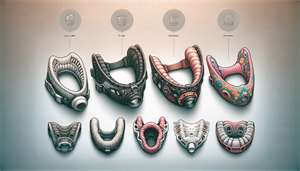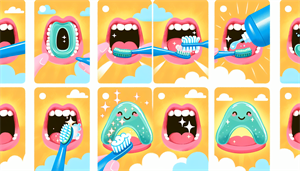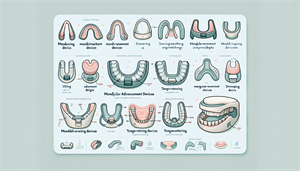Struggling with snoring? A snoring mouthpiece with tongue depressor can help reduce it by keeping your airway open. This article covers how these devices work, their benefits, and top recommendations for a better night’s sleep.
Key Takeaways
-
Snoring is caused by airway obstruction during sleep, influenced by factors like alcohol consumption, obesity, and sleeping position.
-
Snoring mouthpieces, including Mandibular Advancement Devices (MADs) and Tongue-Retaining Devices (TRDs), work by keeping the airway open and can significantly enhance sleep quality.
-
Choosing the right snoring mouthpiece involves considering fit, material, adjustability, and comfort to ensure effectiveness and long-term satisfaction.
Understanding Snoring and Its Causes

Snoring is a common phenomenon that occurs when airflow through the mouth and nose is partially obstructed during sleep. This obstruction causes the tissues in the throat to vibrate, producing the characteristic sound of snoring.
Several factors contribute to this condition, including:
-
Alcohol consumption
-
Nasal congestion
-
Obesity
-
Anatomical variations
When the airway is restricted due to chronic congestion, being overweight, or even tiredness, it can lead to snoring. The relaxation of tongue and throat tissues during sleep further exacerbates this issue, allowing the airway to vibrate and produce the snoring sound.
Obstructive sleep apnea is a more severe form of sleep-disordered breathing where the airway becomes narrowed or blocked during sleep, causing heavy snoring and breathing pauses. Although not all individuals who snore have sleep apnea, heavy snoring is often linked to this condition.
Sleeping on one’s back is another common trigger, as it can cause the airway to narrow further, increasing the likelihood of snoring. The relaxation of throat muscles during sleep can lead to the collapse of the airway, contributing to the snoring problem. Identifying these causes can help in discovering effective snoring solutions.
What is a Snoring Mouthpiece with Tongue Depressor?

A snoring mouthpiece with a tongue depressor is a specialized device designed to help individuals reduce or stop snoring by widening the airway. These mouthpieces function by either forcing the lower jaw forward or holding the tongue in place, thereby keeping the airway open.
Tongue-Retaining Devices (TRDs) specifically work by holding the tongue down or pulling it forward to prevent it from blocking the airway during sleep. Some devices, such as the CareFusion ApneaRx, achieve this by moving the jaw forward to expand the breathing passages and reduce snoring.
These anti-snoring devices are generally safe for individuals over 18 and can often be obtained without a prescription, making them accessible to many. However, some users may need to try different models to find the best fit and comfort level.
Types of Anti-Snoring Mouthpieces
Anti-snoring mouthpieces primarily fall into two categories: Mandibular Advancement Devices (MADs) and Tongue-Retaining Devices (TRDs). MADs work by physically repositioning the jaw to increase airflow, which can alleviate snoring and improve sleep quality. They are typically made from thermoplastic materials that soften when heated, allowing for a custom fit when molded by the user.
Some MADs offer adjustable advancement levels, enabling users to customize the jaw position for maximum comfort and effectiveness. On the other hand, TRDs secure the tongue in a forward position to prevent airway blockage, making them suitable for users who cannot wear MADs.
TRDs are generally lighter and may be more comfortable for some users, though they typically lack the customization features of MADs. The effectiveness of both MADs and TRDs can vary among individuals, depending on the cause of their snoring. TRDs exert less pressure on the teeth and jawbone compared to MADs, which may make them preferable for some users.
Customization options differ significantly, with MADs offering boil-and-bite fitting, while TRDs usually have a universal design.
How Do Tongue Retaining Devices Work?
Tongue Retaining Devices (TRDs) work by keeping the tongue positioned forward to enhance airflow and minimize snoring. The primary goal of these devices is to create more space at the back of the throat by pulling the tongue forward.
TRDs utilize suction to pull the tongue slightly forward due to negative pressure, which helps keep the airway open. This design can be particularly beneficial for individuals who may not have strong enough teeth to support a mandibular advancement device.
Using a snoring mouthpiece can significantly enhance airflow, leading to improved oxygen delivery during sleep. This not only helps reduce snoring but also promotes better sleep quality and overall health.
Benefits of Using a Snoring Mouthpiece with Tongue Depressor

Using a snoring mouthpiece with a tongue depressor can significantly improve sleep quality by reducing the frequency and intensity of snoring. Devices like the American Sleep Dentistry Oral Appliance have been shown to reduce heavy snoring associated with obstructive sleep apnea, thus enhancing the overall sleep experience.
Chronic snoring can lead to daytime sleepiness, fatigue, and mood swings. Using a snoring mouthpiece can alleviate these issues, enhancing focus and reducing accident risks. Custom-made mouth guards not only fit better but also provide significant comfort during use, making them more effective and reducing the likelihood of discomfort.
Mouth guards designed for sleep apnea can be tailored for optimal comfort while maintaining their therapeutic effectiveness. Combining comfort and effectiveness is key to ensuring consistent use and achieving desired results.
Potential Side Effects and Discomfort
While snoring mouthpieces can be highly effective, some users may experience discomfort, pain, or ineffectiveness, particularly those with severe snoring. The use of tongue-retaining devices can lead to excessive drooling and discomfort for some individuals. Side effects like increased salivation or difficulty swallowing may occur when using these devices.
Long-term use of Mandibular Advancement Devices (MADs) may lead to discomfort or jaw pain, especially if the device is not well-fitted. Additionally, some users may experience tooth and gum pain.
Certain oral appliances, such as the SmartGuard RX, may cause dry mouth. If a mouthpiece leads to difficulty closing the mouth, applying a lubricant can help ease the issue. Wearing a mouthpiece for short intervals initially can help users adapt to it and minimize discomfort.
Choosing the Right Snoring Mouthpiece

Selecting the right anti-snoring mouthpiece involves considering factors such as fit, material, adjustability, and comfort. A proper fit is crucial for effectiveness, ideally achieved with impressions by a qualified dentist.
The material quality of mouthpieces, often made from silicone resin or thermoplastic, plays a vital role in comfort and longevity. Some mouthpieces offer manual adjustments to enhance comfort, allowing changes up to 10mm for a more personalized fit.
Considering these factors helps users find a mouthpiece that reduces snoring while providing comfort and durability. Investing in a high-quality mouthpiece ensures long-term benefits and satisfaction.
Top Recommended Snoring Mouthpieces with Tongue Depressors
When it comes to choosing a snoring mouthpiece, certain products stand out for their effectiveness and user satisfaction.
Here, we highlight the top recommended snoring mouthpieces with tongue depressors that offer customizable fits and superior performance.
Good Morning Snore Solution
The Good Morning Snore Solution is designed for a universal fit, requiring no adjustments for use. This simplicity makes it an attractive option for those looking for an easy-to-use and effective anti-snoring device. Its unique design gently moves the tongue forward, keeping the airway open and reducing snoring.
Users have reported high satisfaction with the Good Morning Snore Solution, citing significant reductions in snoring and improved sleep quality. Its user-friendly design and effectiveness make it a top choice among anti-snoring mouthpieces.
ZYPPAH Anti-Snoring Hybrid Oral Mouthpiece
The ZYPPAH Anti-Snoring Hybrid Oral Mouthpiece is another excellent option for snorers. This device combines the functions of a mandibular advancement device with a tongue stabilizing feature. It pulls the jaw forward and holds the tongue in place, effectively keeping the airway open and reducing snoring.
However, some users have noted that the ZYPPAH mouthpiece might be too large for individuals with smaller mouths, which can affect comfort and effectiveness. Nonetheless, its innovative design and dual-action approach position it as a strong contender among anti-snoring devices.
Airway Management myTAP Oral Appliance
The myTAP Oral Appliance offers adjustable lower jaw advancement features up to 22mm, enhancing its effectiveness in managing airway obstructions. This level of adjustability ensures a personalized fit, which is crucial for both comfort and effectiveness.
One of the standout features of the myTAP Oral Appliance is its customization process, facilitated using a boil-and-bite kit. This allows users to create a personalized fit in the comfort of their own home. Additionally, the device is reusable and can be remolded when needed, ensuring long-term use and adaptability.
Users have praised the myTAP for its comfort and the significant improvement in their sleep quality. Its advanced features and user-friendly design make it one of the best anti-snoring mouthpieces available.
Customization and Adjustability
Customization directly influences the comfort and effectiveness of a mouthpiece, ensuring easy breathing and sound sleep. Mouthpieces like the SnoreRx Plus feature superior customization capabilities, allowing for a tailored fit to the user’s oral structure.
The myTAP Oral Appliance, for example, can be remolded for an improved fit, enhancing its reusability and user experience. The majority of anti-snoring mouthpieces utilize the boil-and-bite method for customization, which involves heating the material to soften it, then biting down to create a personalized fit.
The CareFusion ApneaRx offers a highly customizable design with a boil-and-bite template and allows for lower jaw adjustments in 1-millimeter increments. Also, the SnoreRx Plus allows for boil-and-bite molding, which enables users to achieve a custom fit aligned with their anatomical requirements.
Another option, the SmartGuard RX mouthpiece, features a boil-and-bite design that permits significant customization to enhance comfort.
Cleaning and Maintenance

Cleaning the device daily is crucial to prevent infections and odors. Daily cleansing of snoring mouthpieces prevents bacteria growth, which could otherwise lead to unpleasant smells and potential health issues.
Common cleaning methods include using a toothbrush, toothpaste, and warm water to ensure the device remains hygienic. Users should consider the ease of cleaning when selecting a mouthpiece to maintain hygiene. Models with hinges or extra parts may be more difficult to clean, which is an important factor to consider when making a purchase.
Regular maintenance and cleaning of snoring mouthpieces ensure their longevity and effectiveness, contributing to quality sleep and overall health.
Comparing Costs: MADs vs. TRDs
Many anti-snoring mouthpieces, including both mandibular advancement devices (MADs) and tongue-retaining devices (TRDs), fall within an overall price range of $50 to $150. Mandibular advancement devices (MADs) typically cost between $75 and $150, while tongue-retaining devices (TRDs) are generally priced below $100. The average cost of an MAD can be higher than that of a TRD due to the customization involved. Custom-fitted MADs can be significantly more expensive than over-the-counter options, but they offer a more precise fit and greater comfort.
When comparing costs, considering the value and effectiveness of each type is crucial. While MADs offer more customization and potentially greater comfort, TRDs are a more affordable option that can still provide significant relief from snoring.
Lifestyle Changes to Complement Mouthpiece Use
Reducing weight can significantly decrease the severity of snoring in individuals. Additionally, sleeping on one’s side rather than the back can help prevent snoring by keeping the airway open. Avoiding alcohol consumption before bedtime is recommended as it can relax throat muscles and worsen snoring.
Lifestyle changes such as losing weight, sleeping on your side, and avoiding alcohol consumption can effectively complement the use of snoring mouthpieces. Incorporating these lifestyle changes can enhance the effectiveness of snoring mouthpieces, leading to better sleep quality and overall health.
Summary
Understanding the causes of snoring and the available solutions is crucial for improving sleep quality and overall health. Snoring mouthpieces, particularly those with tongue depressors, offer an effective solution for many individuals.
Choosing the right mouthpiece involves considering factors like fit, material, adjustability, and comfort. Customization and regular maintenance are key to ensuring the effectiveness and longevity of these devices.
In conclusion, by selecting the right snoring mouthpiece and incorporating complementary lifestyle changes, individuals can achieve better sleep and improved health. Take the first step towards a restful night’s sleep and explore the top recommended snoring mouthpieces today.
Frequently Asked Questions
What causes snoring and how can it be treated?
Snoring is primarily caused by factors such as alcohol consumption, nasal congestion, obesity, and anatomical variations. Treatment often involves lifestyle changes and the use of anti-snoring devices like mouthpieces and tongue retainers.
What is the difference between MADs and TRDs?
MADs reposition the jaw to enhance airflow, whereas TRDs prevent the tongue from falling back to maintain an open airway. Both devices aim to reduce snoring through distinct mechanisms.
Are snoring mouthpieces safe to use?
Snoring mouthpieces are generally safe for adults over 18, but it's important to consult with a dentist if you have any underlying medical conditions. Your health should always come first when considering treatment options.
How do I choose the right snoring mouthpiece?
Choosing the right snoring mouthpiece involves ensuring a proper fit, selecting a comfortable material, and considering adjustability. For the best results, a custom-fitted option from a dentist is highly recommended.
Can lifestyle changes enhance the effectiveness of snoring mouthpieces?
Absolutely, lifestyle changes like weight loss, side sleeping, and avoiding alcohol before bed can significantly enhance the effectiveness of snoring mouthpieces. Implementing these strategies can lead to a more restful sleep and reduced snoring.


